#Smart Education and Learning Market trends
Explore tagged Tumblr posts
Text
ASEAN Smart Education and Learning Market Is Estimated To Witness High Growth Owing To Technological Advancements

The global ASEAN Smart Education and Learning Market is estimated to be valued at US$ 73,787.2 Mn in 2019 and is expected to exhibit a CAGR of 21.7% over the forecast period 2020-2027, as highlighted in a new report published by Coherent Market Insights. Market Overview: The ASEAN Smart Education and Learning market refers to the integration of technology in the education sector to enhance learning experiences and outcomes. This market offers various products and solutions such as e-learning platforms, educational software, learning management systems, and digital content. These products provide advantages such as personalized learning, interactive content, remote accessibility, and cost-effectiveness. The need for smart education solutions has increased due to the growing demand for quality education, advancements in technology, and the increasing penetration of digital devices in the ASEAN region. Market Key Trends: One key trend in the ASEAN Smart Education and Learning market is the adoption of Artificial Intelligence (AI) and Machine Learning (ML) technologies. AI and ML technologies are being utilized in educational platforms to analyze student data, personalize learning experiences, and offer intelligent content recommendations. For example, e-learning platforms can track students' progress, identify knowledge gaps, and provide tailored suggestions for improvement. This trend not only improves the efficiency of educational processes but also enhances student engagement and motivation. PEST Analysis: Political: The political landscape in the ASEAN region plays a significant role in shaping policies and regulations related to education. Governments are increasingly focusing on digital transformation in education and investing in initiatives to promote smart learning. Economic: The economic growth of ASEAN countries impacts the spending capacity of individuals, schools, and institutions. With the rise in disposable income and the importance placed on education, there is a growing willingness to invest in smart education solutions. Key Takeaways: - The global ASEAN Smart Education and Learning Market Trend is expected to witness high growth, exhibiting a CAGR of 21.7% over the forecast period, due to increasing demand for quality education and advancements in technology. - Among the ASEAN countries, Singapore is anticipated to be the fastest-growing and dominating region in the smart education market. Singapore's strong digital infrastructure, government initiatives, and focus on education provide a favorable environment for the adoption of smart learning solutions. - Key players operating in the global ASEAN Smart Education and Learning market include Adobe Systems Incorporated, Unit4 N.V., Blackboard Inc., Extramarks Education Pvt. Ltd., Educomp Solutions Ltd., Saba Software, Inc., Scholastic Corporation, NIIT Ltd., Cisco Systems Inc., and Smart Technologies, Inc. These players are focusing on product development, strategic partnerships, and mergers and acquisitions to enhance their market presence. In conclusion, the ASEAN Smart Education and Learning market is poised for significant growth in the coming years. The adoption of AI and ML technologies, favorable government initiatives, and advancements in technology will drive the market forward. With Singapore leading the way in the ASEAN region, key players in the market are positioning themselves to capitalize on the growing demand for smart education solutions.
#ASEAN Smart Education and Learning#ASEAN Smart Education and Learning Market#ASEAN Smart Education and Learning Market Size#ASEAN Smart Education and Learning Market Growth#ASEAN Smart Education and Learning Market Trend#Smart Technologies
0 notes
Text
#Smart Education and Learning Market#Smart Education and Learning Market Trend#Smart Education and Learning Market Demand#Smart Education and Learning Market Insights#Smart Education and Learning Market Growth
0 notes
Text
AI & IT'S IMPACT
Unleashing the Power: The Impact of AI Across Industries and Future Frontiers
Artificial Intelligence (AI), once confined to the realm of science fiction, has rapidly become a transformative force across diverse industries. Its influence is reshaping the landscape of how businesses operate, innovate, and interact with their stakeholders. As we navigate the current impact of AI and peer into the future, it's evident that the capabilities of this technology are poised to reach unprecedented heights.
1. Healthcare:
In the healthcare sector, AI is a game-changer, revolutionizing diagnostics, treatment plans, and patient care. Machine learning algorithms analyze vast datasets to identify patterns, aiding in early disease detection. AI-driven robotic surgery is enhancing precision, reducing recovery times, and minimizing risks. Personalized medicine, powered by AI, tailors treatments based on an individual's genetic makeup, optimizing therapeutic outcomes.
2. Finance:
AI is reshaping the financial industry by enhancing efficiency, risk management, and customer experiences. Algorithms analyze market trends, enabling quicker and more accurate investment decisions. Chatbots and virtual assistants powered by AI streamline customer interactions, providing real-time assistance. Fraud detection algorithms work tirelessly to identify suspicious activities, bolstering security measures in online transactions.
3. Manufacturing:
In manufacturing, AI is optimizing production processes through predictive maintenance and quality control. Smart factories leverage AI to monitor equipment health, reducing downtime by predicting potential failures. Robots and autonomous systems, guided by AI, enhance precision and efficiency in tasks ranging from assembly lines to logistics. This not only increases productivity but also contributes to safer working environments.
4. Education:
AI is reshaping the educational landscape by personalizing learning experiences. Adaptive learning platforms use AI algorithms to tailor educational content to individual student needs, fostering better comprehension and engagement. AI-driven tools also assist educators in grading, administrative tasks, and provide insights into student performance, allowing for more effective teaching strategies.
5. Retail:
In the retail sector, AI is transforming customer experiences through personalized recommendations and efficient supply chain management. Recommendation engines analyze customer preferences, providing targeted product suggestions. AI-powered chatbots handle customer queries, offering real-time assistance. Inventory management is optimized through predictive analytics, reducing waste and ensuring products are readily available.
6. Future Frontiers:
A. Autonomous Vehicles: The future of transportation lies in AI-driven autonomous vehicles. From self-driving cars to automated drones, AI algorithms navigate and respond to dynamic environments, ensuring safer and more efficient transportation. This technology holds the promise of reducing accidents, alleviating traffic congestion, and redefining mobility.
B. Quantum Computing: As AI algorithms become more complex, the need for advanced computing capabilities grows. Quantucm omputing, with its ability to process vast amounts of data at unprecedented speeds, holds the potential to revolutionize AI. This synergy could unlock new possibilities in solving complex problems, ranging from drug discovery to climate modeling.
C. AI in Creativity: AI is not limited to data-driven tasks; it's also making inroads into the realm of creativity. AI-generated art, music, and content are gaining recognition. Future developments may see AI collaborating with human creators, pushing the boundaries of what is possible in fields traditionally associated with human ingenuity.
In conclusion, the impact of AI across industries is profound and multifaceted. From enhancing efficiency and precision to revolutionizing how we approach complex challenges, AI is at the forefront of innovation. The future capabilities of AI hold the promise of even greater advancements, ushering in an era where the boundaries of what is achievable continue to expand. As businesses and industries continue to embrace and adapt to these transformative technologies, the synergy between human intelligence and artificial intelligence will undoubtedly shape a future defined by unprecedented possibilities.
19 notes
·
View notes
Text
Top Futuristic AI Based Applications by 2024
2024 with Artificial Intelligence (AI) is the backdrop of what seems to be another revolutionary iteration across industries. AI has matured over the past year to provide novel use cases and innovative solutions in several industries. This article explores most exciting AI applications that are driving the future.
1. Customized Chatbots
The next year, 2024 is seeing the upward trajectory of bespoke chatbots. Google, and OpenAI are creating accessible user-friendly platforms that enable people to build their own small-scale chatbots for particular use cases. These are the most advanced Chatbots available in the market — Capable of not just processing text but also Images and Videos, giving a plethora of interactive applications. For example, estate agents can now automatically create property descriptions by adding the text and images of listings thatsurgent.
2. AI in Healthcare

AI has found numerous applications in the healthcare industry, from diagnostics to personalized treatment plans. After all, AI-driven devices can analyze medical imaging material more accurately than humans and thus among other things help to detect diseases such as cancer at an early stage. They will also describe how AI algorithms are used to create tailored treatment strategies personalized for each patient's genetics and clinical past, which helps enable more precise treatments.
3. Edge AI
A major trend in 2024 is Edge AI It enables computer processing to be done at the edge of a network, rather than in large data centers. Because of its reduced latency and added data privacy, Edge AI can be used in applications like autonomous vehicles transportations, smart cities as well as industrial automation. Example, edge AI in autonomous vehicles is able to get and process real-time data, increasing security by allowing faster decision-making.
4. AI in Finance
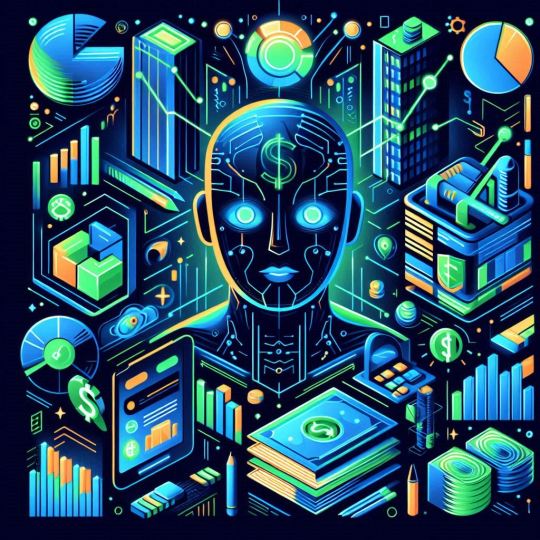
Today, the financial sector is using AI to make better decisions and provide an even stronger customer experience. Fraud detection, risk assessment and customised financial advice have introduced insurance into the AI algorithm. AI-powered chatbots and virtual assistants are now common enough to be in use by 2024, greatly assisting customers stay on top of their financial well-being. Those tools will review your spending behavior, write feedback to you and even help with some investment advices.
5. AI in Education
AI is revolutionizing education with individualized learning. These AI-powered adaptive learning platforms use data analytics to understand how students fare and produces a customised educational content (Hoos, 2017). This way, students get a tailored experience and realize better outcomes. Not only that, AI enabled tools are also in use for automating administrative tasks which shortens the time required by educators on teaching.
6. AI in Job Hunting

This is also reverberating in the job sector, where AI technology has been trending. With tools like Canyon AI Resume Builder, you can spin the best resumé that might catch something eye catchy recruiter among a dozen others applications he receives in-between his zoom meeting. Using AI based tools to analyze Job Descriptions and match it with the required skills, experience in different job roles help accelerating the chances of a right fit JOB.
7. Artificial Intelligence in Memory & Storage Solutions
Leading AI solutions provider Innodisk presents its own line of memory and storage with added in-house designed AI at the recent Future of Memory & Storage (FMS) 2024 event. Very typically these are solutions to make AI applications easier, faster and better by improving performance scalability as well on the quality. This has huge implications on sectors with substantial data processing and storage demands (healthcare, finance, self-driving cars).
Conclusion

2024 — Even at the edge of possible, AI is revolutionizing across many industries. AI is changing our lives from tailored chatbots and edge AI to healthcare, finance solutions or education and job search. This will not only improve your business profile as a freelancer who create SEO optimized content and write copies but also give your clients in the writing for business niche some very useful tips.
#ai#ai in healthcare#ai in finance#ai in wealth management#ai in business#AI trends#artificial intelligence#advanced technologies#innovation#technological advancements
4 notes
·
View notes
Text
FORE School of Management: A Premier Institution for Future Business Leaders
When it comes to pursuing a management degree in India, FORE School of Management stands out as a top choice for aspiring business leaders. Established in 1981, the institute has consistently been ranked among the best business schools in the country. Located in the heart of South Delhi, FORE (Foundation for Organizational Research and Education) offers a dynamic learning environment that blends academic rigor with practical experience. This blog delves into why FORE School of Management should be on your radar if you’re looking to excel in the world of business.

Academic Excellence at FORE School of Management
One of the primary reasons behind the success of FORE School of Management is its commitment to academic excellence. The institute offers a range of programs including:
Post Graduate Diploma in Management (PGDM): FORE’s flagship program, recognized for its cutting-edge curriculum that aligns with industry trends.
PGDM in International Business: A specialized program focusing on the global aspects of business management.
Executive PGDM: Tailored for working professionals, this course offers flexible learning without compromising on content.
PGDM in Big Data Analytics: Preparing future leaders to handle complex data-driven decision-making.
Each of these programs is designed to equip students with both theoretical knowledge and practical skills necessary for navigating today’s business challenges.
Industry-Centric Curriculum
FORE School of Management understands that the corporate world is constantly evolving. To ensure that students are prepared for these changes, the curriculum is regularly updated in consultation with industry experts. The school’s focus on experiential learning through case studies, live projects, internships, and workshops sets it apart from other business schools. This approach bridges the gap between classroom learning and real-world business applications, ensuring that graduates are industry-ready from day one.
World-Class Faculty
A business school is only as good as its faculty, and at FORE School of Management, students are mentored by some of the best minds in the academic and business worlds. The faculty comprises experienced academicians, researchers, and industry professionals who bring a wealth of knowledge and real-world insights into the classroom. Their expertise spans various disciplines, including marketing, finance, operations, human resources, and data analytics, among others.
State-of-the-Art Infrastructure
FORE School of Management provides students with a modern, tech-enabled campus that fosters learning and innovation. The school boasts:
Smart Classrooms: Equipped with the latest technology to enhance interactive learning.
Library and Information Centre: A vast repository of books, journals, and digital resources for research and study.
Computer Labs: Cutting-edge infrastructure for data analytics and other specialized software training.
Hostel Facilities: Comfortable accommodation for outstation students, ensuring a conducive living environment.
The campus also offers various recreational and fitness facilities, making it a holistic space for personal and professional development.
Strong Industry Connections and Placement Records
One of the standout features of FORE School of Management is its robust placement record. The institute has consistently attracted top-tier companies across sectors for campus recruitment. Students have landed roles in organizations like Deloitte, KPMG, EY, PwC, Nestlé, HCL, and many more.
The school’s Corporate Interaction Division (CID) plays a crucial role in fostering these relationships by organizing seminars, guest lectures, and industry visits. These initiatives provide students with the opportunity to network with industry leaders and gain valuable insights into current business practices.
Focus on Entrepreneurship and Innovation
In today’s fast-paced business world, the ability to innovate is crucial for success. FORE School of Management encourages entrepreneurial thinking and supports budding entrepreneurs through its various initiatives. The institute has an Entrepreneurship Development Cell (EDC) that provides mentorship, resources, and opportunities for students to turn their business ideas into reality.
Global Exposure
In a globalized business environment, having international exposure can set you apart. FORE School of Management offers various exchange programs and partnerships with international universities, providing students with a global perspective on business management. These programs help students gain insights into different markets, cultures, and business practices, making them well-rounded professionals ready to take on global challenges.
Conclusion
Choosing the right business school is a critical decision, and FORE School of Management offers everything you need to succeed in today’s competitive business landscape. With its strong focus on academic excellence, industry relevance, innovation, and global exposure, FORE continues to be a leader in management education. If you’re looking to build a successful career in business, FORE School of Management is undoubtedly an institution worth considering.
#fore school of management#education#higher education#colleges#education news#admissions#universities#FORE School#mba#news#students#educationnews
2 notes
·
View notes
Text
The Journey to Becoming a Makeup Artist After 12th Grade

After finishing makeup courses after 12th grade, are you a developing makeup enthusiast wondering where a career in the beauty sector can take you? The opportunities are infinite, ranging from working as a freelance makeup artist to taking on internal jobs and professional roles like makeup consultant or beauty influencer. Developing your skills, learning new things constantly, and using smart job application strategies are all essential to a successful career as a makeup artist. This post explores the many career options, necessary competencies, and job application techniques to help you launch your beauty career after high school and succeed in the cutthroat makeup market.
Potential Career Paths
Freelance Makeup Artist: After completing makeup artist courses after the 12th, offer services on their own, frequently specializing in bridal or editorial areas.
In-House Artist: Employed by cosmetic brands, salons, or spas.
Professional Roles: After earning a diploma in makeup artist after 12th, jobs as a makeup consultant, beauty influencer, or educator in a beauty school.
Knowing these industries and job titles enables you to locate your specialty and adjust your training appropriately.
Continuous Learning & Staying Updated in the Industry
After completing makeup courses after 12th, one must continue to learn to keep ahead in the makeup field. Keeping up with emerging trends and techniques is also helpful to maintain competitiveness. Attending workshops or continuing education classes can help you advance your knowledge and become familiar with the newest tools and techniques.
Skill Development for Aspiring Makeup Artists
How to become a makeup artist in India after completing your 12th grade? Becoming a makeup artist demands devotion and constant practice.
Your portfolio acts as a visual CV, showcasing your experience and qualifications to prospective employers or clients.
By following these below steps, you can improve your methods and become more adaptable in responding to any kind of request from a client.Here are some crucial aspects to pay attention to:
1. Exercising on a Variety of Skin Types and Tone
Working with different skin kinds and tones will help you improve your abilities. This leads to improved outcomes by assisting you in understanding how various products respond on various skin types.
2. Compiling an Exhibit
It is essential to have a professional portfolio that displays the range of styles you have created. This may consist of:
Special effects makeup
Editorial looks
Bridal makeup
Daily beauty looks
Employment Applications & Opportunities for Freelance
how to become makeup artist after 12th?Starting out in the industry means being proactive and well-prepared when applying to salons or studios. Here are some pointers:
Advice on Applying to Studios or Salons
Create an Impressive Resume: Emphasize your training, education, and any practical experience you may have obtained from assistant positions or internships.
Tailor Your Application: After taking makeup courses after 12th, personalize your cover letter and résumé for each salon or studio to demonstrate that you are aware of their unique requirements.
Make Use of Your Network: Reach out to people you met at workshops or internships to ask for recommendations or introductions.
Exhibit Your Portfolio: When attending interviews, bring a hard copy portfolio of your work, and make sure your internet portfolio reflects your post for makeup courses after 12th.
Top 5 Makeup Academies of India
We have talked so far about makeup courses after 12th grade.You must now be searching for some of the top academies to launch your career in beauty after completing your 12th grade education.The majority of institutes provide thorough diploma programs in hair styling, makeup.
Meribindiya International Academy
SMA International Makeup Academy
Meenakshi Dutt Makeup Academy
Shweta Gaur Makeup Academy
Atul chauchan makeover Academy
Final Thoughts
For those who want to become makeup artist courses after 12th, the book provides a variety of career options, stressing the value of ongoing education, skill enhancement, and successful job search techniques. People can improve their job chances and navigate the makeup industry more skillfully by being aware of these components.
2 notes
·
View notes
Text
Invest Smart, Start Strong: Beginner Stock Trading Course at Fuad Academy
The key to successful investing lies in understanding the market and making informed decisions. Fuad Academy’s Beginner Stock Trading Course equips you with the knowledge and tools you need to start investing with confidence and achieve your financial goals. visit us: تعليم الاسهم
Course Highlights:
Essential Concepts: Gain a deep understanding of how the stock market works, including the factors that influence stock prices and how to read market trends.
Portfolio Management: Learn how to build and manage a diversified investment portfolio that aligns with your financial objectives.
Risk and Reward: Understand the balance between risk and reward, and learn strategies to maximize returns while minimizing potential losses.
Expert-Led Sessions: Benefit from the insights and experience of our expert instructors, who have a proven track record of success in the stock market.
Interactive Tools: Access our range of interactive tools and resources, including trading simulators, market trackers, and analytical tools, to enhance your learning experience.
Why Choose Fuad Academy? Fuad Academy is committed to providing a comprehensive education in stock trading that is accessible to beginners. Our course is designed to give you the confidence and skills to make smart investment decisions and build a prosperous financial future. Start investing smartly with Fuad Academy today. Visit us at دورة اسهم للمبتدئين to learn more.
3 notes
·
View notes
Text
Crafting a Comprehensive Marketing Plan for Your Rehabilitation Center
In the healthcare industry, particularly within the realm of rehabilitation services, having a solid marketing plan is essential for reaching your target audience, attracting clients, and establishing your center as a trusted provider of care. A wellcrafted marketing plan not only helps in promoting your services but also in differentiating your center from competitors and ultimately driving growth and success. In this comprehensive guide, we'll delve into the key components of creating an effective marketing plan tailored specifically for a rehabilitation center.
I. Introduction to Marketing for Rehabilitation Centers
Setting the Stage: Brief overview of the importance of marketing in the healthcare sector, particularly for rehabilitation centers.
Understanding the Audience: Highlighting the diverse demographic groups that may require rehabilitation services and the significance of targeting them effectively.
II. Market Analysis
Assessing the Competitive Landscape: Conducting a thorough analysis of existing rehabilitation centers in your area, including their services, reputation, and target demographics.
Identifying Opportunities and Challenges: Pinpointing gaps in the market where your center can excel and recognizing potential obstacles that may hinder your marketing efforts.
III. Defining Your Unique Selling Proposition (USP)
Highlighting Your Center's Strengths: Identifying the unique features and strengths of your rehabilitation center, such as specialized programs, experienced staff, or stateoftheart facilities.
Addressing Client Needs: Understanding the specific needs and preferences of your target audience and how your center can fulfill them better than competitors.
IV. Setting Marketing Objectives and Goals
SMART Goals: Establishing specific, measurable, achievable, relevant, and timebound objectives for your marketing efforts, such as increasing client inquiries, improving brand awareness, or expanding services to new demographics.
Benchmarking Progress: Creating metrics to track the success of your marketing initiatives and regularly evaluating performance against set goals.
V. Developing Strategies and Tactics
Digital Marketing: Leveraging online channels such as social media, search engine optimization (SEO), and content marketing to increase visibility and attract potential clients.
Traditional Marketing: Exploring traditional methods like print advertisements, direct mail campaigns, and community outreach events to reach local audiences effectively.
Referral Programs: Establishing partnerships with healthcare professionals, community organizations, and previous clients to generate referrals and build credibility.
Educational Content: Creating informative content such as blog posts, videos, and webinars to educate the public about rehabilitation services and position your center as an authority in the field.
VI. Implementation Plan
Allocating Resources: Determining the budget, personnel, and tools required to execute your marketing plan effectively.
Timeline and Milestones: Creating a detailed schedule outlining when each marketing initiative will be launched and setting milestones for tracking progress.
Assigning Responsibilities: Delegating tasks to team members or external partners and ensuring clear communication and accountability throughout the implementation process.
VII. Monitoring and Evaluation
Tracking Key Metrics: Monitoring the performance of your marketing activities using metrics such as website traffic, conversion rates, client inquiries, and customer feedback.
Analyzing Results: Reviewing data regularly to identify trends, successes, and areas for improvement, and making adjustments to your marketing strategy accordingly.
Continuous Improvement: Adopting a mindset of continuous learning and adaptation to stay ahead of the competition and meet the evolving needs of your target audience.
VIII. Conclusion
Crafting a comprehensive marketing plan for rehabilitation center is not just about promoting your services—it's about connecting with your audience, addressing their needs, and positioning your center as the top choice for rehabilitation care. By following the steps outlined in this guide, you can develop a strategic marketing plan that not only attracts clients but also fosters longterm growth and success for your center.
2 notes
·
View notes
Text
Unveiling Millionaire Secrets: Keys to Financial Success
Introduction:
Becoming a millionaire is a goal many aspire to achieve, and while there is no one-size-fits-all formula for success, there are common strategies and mindsets that millionaires often share. Unlocking the secrets to financial prosperity involves a combination of smart financial decisions, disciplined saving, and a strategic mindset. Let's delve into some millionaire secrets that can pave the way to financial abundance.
1. **Financial Literacy:**
Millionaires understand the importance of financial education. They invest time in learning about money management, investing, and market trends. By staying informed, they make informed decisions that contribute to their wealth accumulation.
2. **Disciplined Saving and Budgeting:**
One key secret to building wealth is disciplined saving. Millionaires often follow a budget, allocating a portion of their income to savings and investments. Consistent saving, even in small amounts, can accumulate over time and create a financial cushion.
3. **Strategic Investing:**
Successful millionaires don't just save money; they invest wisely. They diversify their portfolios, balancing risk and reward. Whether it's in stocks, real estate, or other assets, strategic investing is a cornerstone of wealth creation.
4. **Entrepreneurial Mindset:**
Many millionaires have an entrepreneurial spirit. They seek opportunities, take calculated risks, and are not afraid of failure. Entrepreneurship allows them to build businesses, create multiple streams of income, and capitalize on innovative ideas.
5. **Long-Term Vision:**
Patience is a virtue when it comes to building wealth. Millionaires often have a long-term perspective, understanding that financial success is a gradual process. They resist the urge for quick gains and focus on sustainable growth over time.
6. **Continuous Learning:**
The wealthiest individuals are avid learners. They stay curious, adapt to changing markets, and embrace new technologies. Continuous learning enables them to stay ahead of the curve and make informed decisions in an ever-evolving financial landscape.
7. **Networking and Relationship Building:**
Networking is a powerful tool in the world of wealth creation. Successful millionaires often surround themselves with like-minded individuals, mentors, and professionals. Building strong relationships opens doors to new opportunities, collaborations, and valuable insights.
8. **Financial Discipline:**
Discipline extends beyond saving; it also involves avoiding unnecessary debt and making well-thought-out financial decisions. Millionaires prioritize needs over wants, distinguishing between essential expenses and luxury purchases.
9. **Resilience in the Face of Challenges:**
Financial setbacks are inevitable, but millionaires are resilient. They view challenges as opportunities to learn and grow. Instead of succumbing to failure, they use setbacks as stepping stones to future success.
Conclusion:
While there is no guaranteed path to becoming a millionaire, understanding and adopting the habits and mindsets of successful individuals can certainly increase one's chances of financial prosperity. The journey to wealth involves a combination of financial literacy, disciplined saving, strategic investing, and a resilient mindset. By incorporating these millionaire secrets into your own financial journey, you can pave the way to a more secure and prosperous future.
Click here to learn more https://www.digistore24.com/redir/372576/RueColeman/
#how to earn money#cryptocurreny trading#how to make money online#crypto#how to save money#how to become a millionaire#how to make#how to#philanthropy#ghostsoap#steps of becoming a millionaire
4 notes
·
View notes
Text
The Reality of a Career in Digital Marketing: Navigating the Digital World

In today’s digital age, “digital marketing” is more than just a trendy phrase; it’s a thriving field that shapes how businesses connect with their audiences. But what does a career in digital marketing really involve, and what can you expect once you step into this dynamic field? Let’s uncover the realities of pursuing a career in digital marketing.

Digital marketing is always changing. From search engines to social media, everything evolves rapidly. This means you’ll need to keep learning to stay up-to-date with the latest trends and techniques. Being in the know is essential.
2. Multifaceted Skill Set:
Digital marketing isn’t just one thing; it’s a bunch of different jobs rolled into one. You might work on things like making websites show up in Google searches, creating content, running ads on Facebook, or sending emails. To do well, you’ll need to become skilled in at least a few of these areas.
3. Data-Driven Decision-Making:
Numbers are a big part of digital marketing. You’ll use data to figure out what’s working and what isn’t. This helps you make smart choices about how to market things online.
4. Creativity and Content:

5. Diverse Career Opportunities:
Digital marketing has a lot of different jobs you can do. You could work on making websites better at showing up in Google searches, creating posts for social media, writing emails to send to customers, or even running ads online. You get to pick what you like best.
6. Client-Centric Work:
If you work at a company or by yourself, you’ll often talk to people who want you to help them with their marketing. This means listening to what they want, telling them how you’ll help, and keeping them happy. Building good relationships with clients is important.
7. Remote Work Possibilities:
Some digital marketing jobs let you work from anywhere, like your house or a coffee shop. This can be nice because it gives you more flexibility with your schedule.
8. Competitive Nature:
Digital marketing is really competitive. Lots of companies want people’s attention online, so it’s a tough place to stand out. You’ll need to work hard and be creative to do well.
9. Networking and Collaboration:
Meeting and talking to other digital marketers is important. You can learn from them, and they might help you get a job someday. Joining groups and going to events is a good way to meet people.
10. Impact on Business Growth:
Digital marketing isn’t just about getting likes on Facebook; it’s about making businesses successful. Your job is to help companies sell more things, get more customers, or become more famous online.
11. Ups and Downs:
Like any job, digital marketing has its good days and bad days. Sometimes you’ll feel great because things are going well, and other times you’ll have challenges to overcome. Being able to learn from mistakes is important.
12. Secure Jobs:

13. Certifications and Education:
Digital marketing is always changing, so you should keep learning new things. Taking courses and getting certifications can help you learn more and show that you’re good at your job.
14. Being Ethical:
Digital marketing isn’t just about getting attention; it’s also about doing things the right way. You’ll need to follow rules and think about what’s fair and honest in your marketing.
15. Career Advancement:
After you’ve been in digital marketing for a while, you might be able to get a better job with more pay and more responsibility. This means you can climb the career ladder.
A job in digital marketing is exciting and always changing. You’ll need to be good at learning new things, solving problems, and using both numbers and creativity. While it can be tough, the chance to make a big impact online and have job security makes digital marketing a cool career choice.
Whether you’re just starting or looking to advance your career, the ACTE TECHNOLOGIES industry welcomes individuals who are passionate about Learning Digital Marketing, creative problem-solving, and making a significant online impact. It’s a world where the digital canvas is vast, and your marketing skills can paint a picture of success for businesses and brands. All the Best :)
#digital marketing#digital marketing tools#marketing#what is digital marketing#digital marketing course#digital marketing training
2 notes
·
View notes
Text
Exploring the World of Data Analytics: Opportunities and Beyond

Describe data analytics. Analyzing data to find useful information, patterns, and trends is known as data analytics. Businesses adore it since it aids in their improvement. It’s similar to solving problems with data.
Why is data analysis so crucial? Consider yourself in possession of a treasure map (data) and the desire to locate the treasure (insights). Your compass is data analytics.
Why it matters is as follows: It aids in your understanding of consumer behavior, market trends, and company performance.
Efficiency: You can discover areas in which your company may save both time and money.Smart decisions: When using data, you may base decisions on facts rather than educated guesswork.
Personalization: Have you ever seen how Netflix suggests shows? That is data analysis.
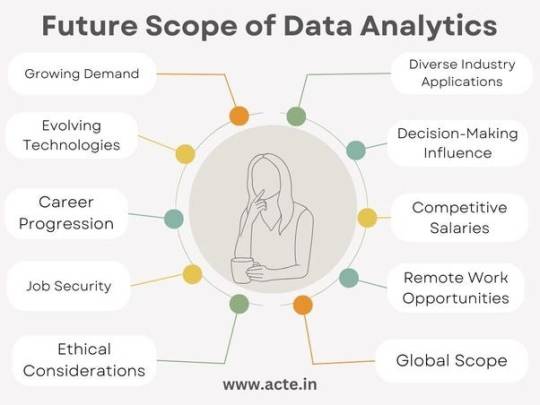
Future Scope of Data Analytics :
High Demand: Many businesses in different industries need data experts because they use data to make smart choices. So, the need for skilled data analysts is growing.
Various Job Fields: Data skills are useful everywhere, not just in one industry. You can work in finance, healthcare, e-commerce, marketing, or technology. This means you have many options for your career.
Tech Keeps Changing: The tools and methods for working with data keep getting better and different. It’s important to keep learning new things, but it also means you can become an expert in a special area.
Helping Decisions: Data people play a big role in helping businesses make important decisions. What you find in data can change how a company plans for the future.
Career Growth: Starting as a data analyst can lead to better and higher-paying jobs like data scientist or machine learning engineer.
Good Pay: Data analysts are paid well. As you get better at your job, you can earn even more.
Job Security: As long as companies use data, they’ll need people who understand it. So, you’ll have a stable job.
Work from Anywhere: You can often do data work from anywhere, giving you flexibility in where you live.
Ethical Data: Data privacy and being fair with data are important. People who can make sure data is used the right way are in demand.
Worldwide Opportunities: Data skills are needed all over the world, so you
can work in different countries if you want.
Careers in Data Analytics:
Data Analyst: The entry point They collect, clean, and analyze data.
Data Scientist: The Experts They use machine learning to solve complex puzzles.
Business Analyst: The bridge between data and business decisions
Big Data Engineer: They manage massive data sets using big data tools.
Healthcare Analyst: They use data to improve healthcare outcomes.
Marketing Analyst: Masters of measuring marketing success
Financial Analyst: They use data for financial strategies.
Sports Analyst: They play with data in the world of sports.
The Future of Data Analytics:
AI and machine learning: Think smarter, not harder. Automation will rule.
IoT Analytics: Connected devices will provide more data than ever.
Ethical Analytics: Data privacy will be a top concern.
Data Visualisation: Making data pretty and easy to understand will be big.
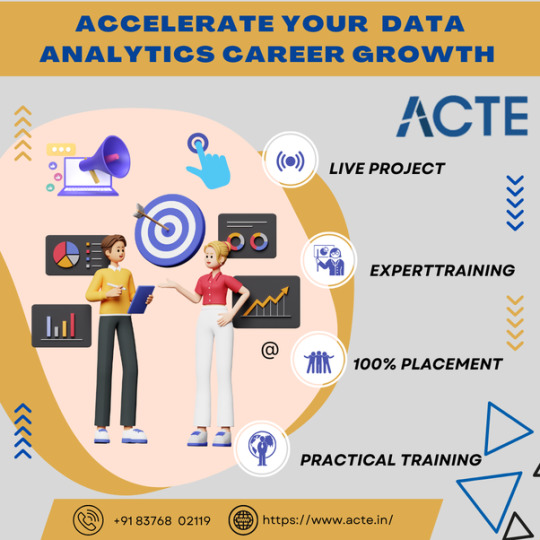
Feel free to get in touch with an ACTE institution if you want to learn more about Data Analytics because they provide certifications and possibilities for job placement. Teachers with experience can improve your learning. These services are available offline and online. Take things slowly and, if you’re interested, think about signing up for a course.
I hope I was able to effectively respond to your query. If it’s not, add it in the comments section. I still think I have a lot to learn.
Consider following me and giving this answer an upvote if you found it to be useful. This will motivate me to post more information on data analytics.
We appreciate you taking the time to read this and voting it up. Enjoy your day.
#data analytics#data analysis#data analytics course#data analyst jobs#data analyst training#data analyst certification#data analyst course
3 notes
·
View notes
Text
"Unveiling the Future: How Data Science is Revolutionizing Upcoming Industries"
Data science continues to have a substantial impact on various industries, and its scope is expected to expand as new technologies emerge and businesses realize the potential of data-driven insights. Here are some upcoming industries where data science is likely to play a significant role:
Healthcare and Life Sciences: Data science can aid in personalized medicine, drug discovery, predictive analytics for patient outcomes, and healthcare operations optimization.
Financial Services: Financial institutions use data science for fraud detection, risk assessment, algorithmic trading, customer behavior analysis, and credit scoring.
Retail and E-Commerce: Data science helps optimize inventory management, pricing strategies, recommendation systems, and customer segmentation for targeted marketing.
Energy and Utilities: The energy sector benefits from data analytics for smart grid management, predictive maintenance of equipment, and energy consumption optimization.
Manufacturing: Data science improves manufacturing processes through predictive maintenance, quality control, supply chain optimization, and demand forecasting.
Agriculture: Precision agriculture utilizes data science to optimize crop yield, resource allocation, pest control, and environmental monitoring.
Transportation and Logistics: Data science plays a role in route optimization, fleet management, demand forecasting, and autonomous vehicles.
Telecommunications: Data science assists in customer churn prediction, network optimization, and personalized service offerings.
Media and Entertainment: Content recommendation, audience segmentation, and analyzing viewer engagement are areas where data science is making an impact.
Real Estate: Data science helps in property price prediction, market trend analysis, and investment decision-making.
Environmental Conservation: Data science aids in monitoring and analyzing environmental data, including climate patterns, pollution levels, and habitat preservation.
Education: Data science can personalize learning experiences, assess student performance, and optimize educational resources.
Government and Public Services: Data-driven decision-making is becoming increasingly important for optimizing public services, policy formulation, and resource allocation.
Insurance: Insurers use data science for risk assessment, claims processing, fraud detection, and customized pricing.
Travel and Tourism: Data science enhances traveler experiences through personalized recommendations, pricing optimization, and destination insights.
Pharmaceuticals: Data science plays a role in drug discovery, clinical trials optimization, and pharmacovigilance.
Smart Cities: The concept of smart cities involves integrating data science for efficient urban planning, traffic management, energy consumption, and public services.
Cybersecurity: Data science helps in identifying and responding to cyber threats by analyzing patterns and anomalies in network data.
As technology continues to advance and businesses recognize the value of data-driven insights, certybox is creating a difference in providing the top professional courses along with job assistance. It's essential for professionals in the field to stay updated with the latest developments and tools to make the most of these opportunities.
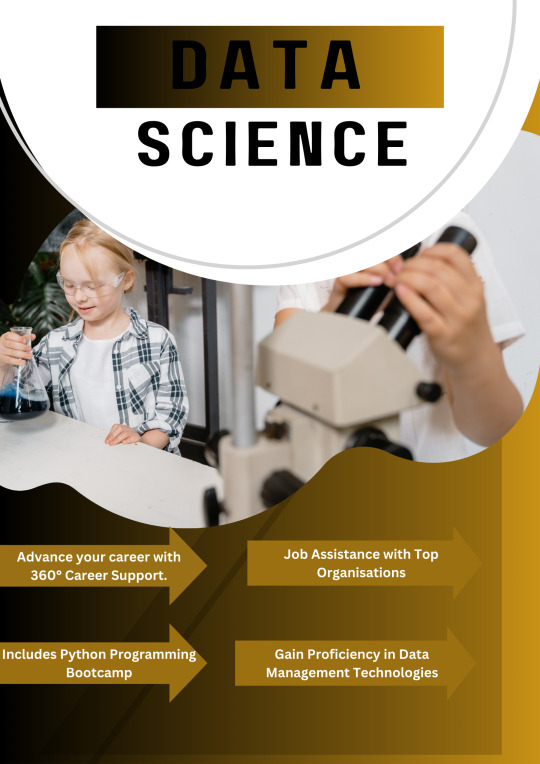
5 notes
·
View notes
Text
How to Make Your First Million Dollars: A Comprehensive Guide to Financial Success!

Introduction:
Dreaming of becoming a millionaire? Turning that dream into a reality is an attainable goal with the right mindset and strategic approach. While it may not happen overnight, making your first million dollars is entirely possible through careful planning, smart investing, and disciplined financial habits. In this comprehensive guide, we will explore essential tips to help you achieve your financial goals and set you on the path to becoming a successful millionaire.

1. Set Clear Goals and Visualize Success: The journey to becoming a millionaire begins with a clear vision. Define your financial objectives and create a roadmap to reach them. Break down your goals into achievable milestones, and keep track of your progress. Visualization techniques can be powerful in keeping you focused and motivated throughout the process.

2. Budget Smartly and Track Your Spending: Financial discipline is crucial when aiming to accumulate wealth. Create a detailed budget that outlines your income, expenses, and savings. Identify areas where you can cut back on unnecessary expenditures and redirect those funds towards investments or savings. Tracking your spending habits allows you to stay in control of your finances and make informed decisions.

3. Invest Wisely and Diversify Your Portfolio: Growing your money through investments is key to building wealth. Educate yourself about different investment options such as stocks, bonds, real estate, mutual funds, and more. Diversifying your investment portfolio spreads risks and can lead to higher returns over time.

4. Increase Your Income and Seek Multiple Streams of Revenue: Boosting your income is a significant step towards achieving financial success. Consider exploring additional revenue streams, like starting a side business, freelancing, or investing in your skills to enhance your earning potential. The more sources of income you have, the faster you can reach your financial goals.

5. Save and Automate Your Savings: Regular saving is the foundation of wealth accumulation. Set up automated savings and investment plans to ensure a portion of your income is automatically allocated towards your financial objectives. Pay yourself first before spending, and let the power of compounding work in your favor.

6. Educate Yourself and Stay Informed: Continuous learning is essential in the pursuit of financial success. Read books, follow financial blogs, attend seminars, and learn from successful entrepreneurs. Staying informed about market trends and financial news will help you make better-informed decisions when it comes to your investments.

7. Embrace Failure and Learn from Mistakes: No successful person has ever achieved greatness without experiencing setbacks. Embrace failure as an opportunity to learn and grow. Evaluate your mistakes, adjust your strategies, and keep moving forward with renewed determination.

8. Network and Collaborate: Surrounding yourself with like-minded individuals can be a powerful catalyst for success. Network with people in your industry or those who share similar financial goals. Seek mentors who can offer guidance and valuable insights. Collaborating with others may open doors to new opportunities and partnerships.

9. Stay Disciplined and Avoid Impulsive Decisions: The journey to a million dollars requires discipline and patience. Stay focused on your goals and avoid impulsive decisions that may undermine your progress. Be mindful of emotional responses to market fluctuations and always base your choices on thorough research and analysis.
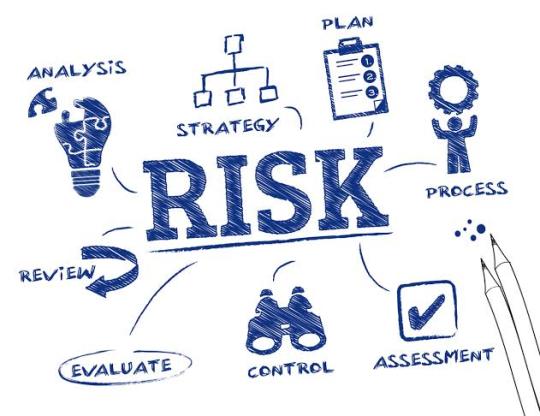
10. Take Calculated Risks: All investments come with some degree of risk. While it's essential to be cautious, taking calculated risks can lead to significant rewards. Assess potential risks and rewards before making any financial decisions. Remember that higher returns often involve higher risks, so diversify your investments to mitigate potential losses.

Conclusion:
Becoming a millionaire is an achievable goal for anyone willing to put in the effort and follow a disciplined approach to finances. Setting clear goals, budgeting wisely, investing intelligently, and continuously educating yourself are the pillars of financial success. Remember that building wealth takes time and perseverance; stay committed to your goals, and success will follow.Above all, maintain a positive mindset and believe in your abilities to overcome obstacles and achieve your dreams. As you progress on your journey to financial freedom, always seek professional advice when needed and remain open to adapting your strategies as circumstances change. With determination and the right financial strategies, you can make your first million dollars and embark on a path towards long-term prosperity.
Get this Free Ebook on The Hidden Credit Secret to $1 Million Dollars - Click here to access now!
2 notes
·
View notes
Text
This is why, so many people advised my generation (I'm about 40) "not to go to school if we didn't understand what we were getting out of it."
There were also many who were not aware of the price of tuition trend who advised me to go, working off nothing more than the average earning power of every level of education. (I'm not going to say some degrees are worthless, because that is not true. But some degrees are overrepresented compared to positions available and some are underrepresented.)
A surprising number of available positions are considered "High School Diploma required" but since many high schools have turned into college prep schools instead of high schools, and therefore no longer teach machine shop or welding or basic electrical work to the level of certification anymore. It's gotten to the point that there's no point in going to high school either.
Go down to your library, or used bookstore, (or amazon.com) and find some technical manuals in whatever subject you want jewellery making, or welding, or beekeeping. Or go down to your county courthouse and find the building inspector's office, and buy a copy of the building code, and just read it.
It won't give you practice doing any of the techniques, but you'll have an idea of the range of skills it would take to be competent in the field. Give you a lot more information about which fields you might want to get into or stay out of than you might get any other way. Then walk into a place of business like that, get a summer internship, look around for who's having the most fun, and find out what it takes to have that position, (education-wise, certification-wise, stress levels, work/life balance-wise, etc), whether you still want it / and think you can manage that. etc.
And the ridiculous part is that technical education(STEM) is exactly how we won the world wars and the Cold War, we know that's what it takes to keep the standard of living moving forward, but we've let two or three generations of youth see that banking and investing, instead of being a basic utility that is meant to lubricate industry for everyone, turn into a many-tentacled leach monster that is sucking it all dry. And when there weren't enough banking jobs available, and not enough people willing to say, investing (not speculating) is actually hard tedious work, but mostly just takes a lot of algebra, here's Securities Analysis 2nd Edition by Graham and Dodd. The Bible of Investing.
Or you can learn calculus and business communication and go into Engineering. Or statistics and go into biology. or both and go into Physics.
But no, of course not, you don't need to learn anything, just buy whatever feels right without doing market research on how you're going to help people with it and lose your shirt in crypto or college debt.
It's not the bank's fault that the car salesman is predatory, nor the car salesman's fault that banks are predatory, but together you cannot trust them.
Same with colleges and banks.
Colleges ought to be saying, Don't trust banks, use this worksheet to calculate the real cost of borrowing money, against the real cost of taking longer to finish your degree if you just take night school. Etc. (Do you already have a job that would allow you to take night school or whatever? How much is that salary?) How much farther ahead or behind will you be at the end of each year for ten years?
The speech I heard for my college orientation went like this: You are all here because you like learning, and you don't mind working, (or vice versa) and you've chosen one of the narrow ranges of fields that are currently growth fields. (smart choice)
But!
You won't get rich working.
Let me say that again.
You won't get rich working.
(Money comes to those who help people.)
You get more money by helping MORE people.
You will get wealthy by leveraging your own specialisation to better help more people. (Several examples to convince us that by the time we graduate, we should be hiring each other for each other's specialties, rather than trying to be independent generalists.)
Also, you can become wealthy by patiently leveraging your growing net worth to help more people help other people. (Which neatly includes, growing your business, investing in other people's businesses, and repairing and managing real estate.)
(A quick example of how he bought broken-down real estate, fixed it up, and found people who actually needed it, to sell it to.)
And then he wrapped up with a tour of the college and help getting our library cards.

They just want there to always be a class of people who are forever in debt. Whether it's chattel slavery, prison, student loan debt, medical debt, renters who will never be able to own a house, etc.
37K notes
·
View notes
Text
The Technology Revolution: How Innovation is Reshaping Our World In the past few decades, technology has evolved at a breakneck pace, revolutionizing nearly every part of our lives. From the way in which we communicate to exactly how we work, shop, and even think, technology continues to shape the present day world. Once we look toward the long run, it's clear that the role of technology will only continue to expand, bringing both opportunities and challenges. This information explores how technology is transforming society, the workforce, and industries, and what we can expect once we move forward. selectstructural.net
1. The Rise of Artificial Intelligence and Automation
Artificial Intelligence (AI) and automation are two of the very most significant technological advancements of the 21st century. AI has made its way into various industries, from healthcare and finance to transportation and entertainment. AI's capability to analyze vast levels of data, recognize patterns, and make decisions has opened doors for improved efficiency, personalized services, and smarter business practices.
Automation, on the other hand, is revolutionizing manufacturing and service industries by reducing human intervention and increasing productivity. While some fear that automation will result in job losses, others argue so it will create new forms of jobs and allow workers to target on higher-level tasks.
2. The Impact of 5G Technology
5G, another generation of mobile network technology, promises to revolutionize exactly how we relate to the entire world around us. With faster download speeds, lower latency, and the capability to connect more devices simultaneously, 5G will fuel the growth of the Internet of Things (IoT), autonomous vehicles, and smart cities. It may also enable better remote work solutions, enhanced video conferencing, and more effective healthcare delivery, among other benefits.
However, the rollout of 5G also presents challenges, including the requirement for updated infrastructure, cybersecurity concerns, and the possibility of increased digital divide, especially in rural areas.
3. Blockchain Technology: Beyond Cryptocurrencies
Blockchain technology, the backbone of cryptocurrencies like Bitcoin, has far-reaching implications beyond digital currencies. Blockchain provides for secure, transparent, and decentralized transactions, that could disrupt industries such as for instance finance, supply chain management, and healthcare. Its potential to reduce fraud, enhance transparency, and increase efficiency helps it be a technology worth watching.
As blockchain continues to mature, its applications are likely to extend to a wide variety of sectors, including government, real estate, and legal services, offering new solutions for data security and record-keeping.
4. The Growing Influence of Data and Privacy Concerns
We are now living in an age where data is one of the very most valuable commodities. Companies leverage data to personalize products and services, drive marketing efforts, and improve customer experiences. Big data analytics and machine learning enable organizations to create more informed decisions and predict future trends.
However, as the quantity of data we generate grows, so do concerns over privacy and security. The necessity to safeguard personal information, prevent data breaches, and regulate how data is collected and used has changed into a significant topic of debate. Striking a balance between innovation and privacy is going to be crucial in the coming years.
5. The Future of Virtual and Augmented Reality
Virtual Reality (VR) and Augmented Reality (AR) are technologies that have the potential to redefine exactly how we communicate with digital content. VR immerses users in a totally virtual environment, while AR overlays digital elements onto the actual world. From gaming and entertainment to education and healthcare, the applications of VR and AR are vast.
In the business world, these technologies offer new ways to engage customers, provide remote training, and enhance collaboration. As hardware becomes less expensive and software more sophisticated, VR and AR are set to become integral areas of our daily lives.
Conclusion
Technology is not only shaping the present; it's laying the groundwork for the future. Whether through AI, 5G, blockchain, data analytics, or immersive experiences, technology is transforming industries and creating new possibilities. While challenges like privacy, security, and ethical concerns must be addressed, the potential great things about technological innovation are vast. The main element will be to embrace the opportunities while navigating the risks, ensuring that technology serves as a force permanently within our increasingly digital world.
0 notes
Text
Unlock Your Career Potential: Explore Top MBA Colleges in Rajasthan
Rajasthan, with its rich culture and rapidly growing economy, has become a top destination for higher education. For students aspiring to pursue a management career, the state is home to some of the best MBA colleges in Rajasthan. These institutions not only offer quality education but also provide the skills and exposure needed to excel in today’s competitive business world.

Why Choose MBA Colleges in Rajasthan?
Studying in Rajasthan offers a perfect blend of academic excellence and cultural diversity. Here’s why pursuing an MBA here is a smart choice:
High-Quality Education: Rajasthan is home to renowned business schools that provide a strong foundation in management principles. These colleges emphasize both theoretical learning and practical applications, ensuring students are ready for real-world challenges.
Affordable Education: Compared to many other states, the cost of education in Rajasthan is relatively lower. This makes it an ideal choice for students looking for quality education at an affordable price.
Diverse Career Opportunities: With growing industries in sectors like tourism, technology, finance, and manufacturing, Rajasthan offers excellent career opportunities for MBA graduates. Many MBA colleges in Rajasthan have strong industry connections, helping students secure internships and placements.
Cultural and Professional Growth: Studying in Rajasthan allows students to immerse themselves in its vibrant culture while preparing for a global career. The combination of traditional values and modern education creates an enriching experience.
Top Features of Leading MBA Colleges in Rajasthan
When choosing a business school, it’s important to look for the right features. Here’s what makes the best MBA Colleges in Rajasthan stand out:
Comprehensive Curriculum: The top institutions offer a curriculum that balances classroom learning with real-world exposure. From marketing and finance to entrepreneurship and analytics, students gain expertise in various domains.
Industry-Integrated Programs: Leading MBA colleges in Rajasthan collaborate with industries to design programs that match the latest trends and demands. Students benefit from internships, live projects, and guest lectures by industry experts.
Focus on Soft Skills: In addition to technical knowledge, these colleges emphasize soft skills like leadership, communication, and teamwork. These skills are crucial for succeeding in the corporate world.
Placement Support: Placement assistance is a key feature of the best MBA programs. Top companies visit campuses to recruit talent, offering roles in diverse sectors with attractive packages.
World-Class Infrastructure: Many MBA colleges in Rajasthan boast modern facilities, including smart classrooms, libraries, computer labs, and hostels. These amenities provide a conducive environment for learning and personal growth.
How to Choose the Right MBA College in Rajasthan
With so many options available, selecting the right business school can be overwhelming. Here are some factors to consider:
Accreditation and Rankings: Look for colleges that are accredited by reputable organizations. Rankings can also provide insights into a college’s reputation and performance.
Specializations Offered: Different colleges offer different MBA specializations. Choose a college that aligns with your career goals, whether it’s marketing, finance, HR, operations, or IT.
Faculty Expertise: The quality of education largely depends on the faculty. Research the qualifications and experience of professors to ensure you’ll be learning from the best.
Placement Record: A strong placement record indicates a college’s credibility and industry connections. Check the average salary packages and companies that recruit from the college.
Campus Environment: A positive and inclusive campus environment can enhance your learning experience. Visit the campus, if possible, to get a feel for the facilities and culture.
Career Opportunities After Studying at MBA Colleges in Rajasthan
Graduates from top MBA colleges in Rajasthan enjoy diverse career opportunities in various industries. Here are some roles you can pursue:
Marketing Manager: Plan and execute marketing strategies to promote products and services.
Financial Analyst: Analyze financial data to help businesses make informed decisions.
Human Resource Manager: Oversee recruitment, training, and employee relations in organizations.
Business Consultant: Provide expert advice to companies on improving their operations and achieving growth.
Entrepreneur: Start your own business and bring your ideas to life with the skills acquired during your MBA.
Top MBA Colleges in Rajasthan to Consider
Here are some of the leading MBA colleges in Rajasthan that are shaping the future of students:
Indian Institute of Management (IIM) Udaipur: Known for its academic rigor and global exposure, IIM Udaipur is one of the premier institutes in Rajasthan.
Jaipuria Institute of Management, Jaipur: With its industry-focused curriculum and excellent placement record, Jaipuria is a top choice for MBA aspirants.
BITS Pilani: BITS Pilani offers a strong MBA program with a focus on innovation and entrepreneurship.
Amity University Jaipur: Amity is renowned for its modern infrastructure, experienced faculty, and global collaborations.
Manipal University Jaipur: Manipal’s MBA program is designed to provide students with a well-rounded education and practical exposure.
Tips to Succeed in Your MBA Journey
Set Clear Goals: Define what you want to achieve from your MBA and align your efforts accordingly.
Stay Updated: Keep yourself informed about the latest trends and developments in the business world.
Participate Actively: Engage in workshops, seminars, and extracurricular activities to enhance your skills and network.
Build a Strong Network: Connect with peers, alumni, and industry professionals to open doors to future opportunities.
Focus on Practical Learning: Apply what you learn in class to real-world scenarios through internships and live projects.
Conclusion
Pursuing an MBA is a transformative experience, and choosing the right college plays a crucial role in your success. Rajasthan offers some of the best options for management education, with institutions that combine academic excellence, industry exposure, and holistic development. Whether you’re aiming for a corporate career or entrepreneurship, the MBA colleges in Rajasthan equip you with the skills and confidence to achieve your dreams.
Take the first step toward a brighter future by exploring your options and applying to the best MBA colleges in Rajasthan today!
If you need further information contact:
523, 5th Floor, Wave Silver Tower, Sec-18 Noida, UP-201301
+91 9711016766
0 notes